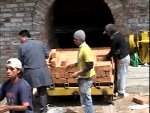All articles
Ferrocement panel houses evaluated in two Universities

The INTEC (Instituto Tecnológico de Santo Domingo) and the CUJAE (Polytechnical University of Havanna) have recently published two Diploma thesis on buildings with ferrocement panels like the ones used by grupo sofonias in the reconstruction of Haiti. Both came to similar conclusions and recommend the technology because of its high resistance to earthquakes and hurricanes and the savings in materials, energy, time and finances
Both diploma works start out with a characterization of ferrocement, discuss its history and the multiple applications in architecture, engineering and boat building over the last 163 years (in 1848 Joseph Lambot patented his fist boat made with "ferciment" in France and in 1948 Luigi Nervi built in Italy roof structures more than 100 meters wide with a thickness of 4 cm). They analyze different size panels, but concentrating on the system today used by EcoSur which was developed by Hugo Wainsthok in Cuba in the eighties of the last century.

Both investigations combined systematic testing of panels with appropriate software programs to model the behavior of the panels under different stress situations and both came to similar, very encouraging results.
 A group of 8 engineering students at INTEC (a leading technical University of the Dominican Republic) then concentrated on analyzing a a single storey house and compare it with a similar house built with a reinforced concrete structure and walls with hollow concrete blocks. Modeling the structure with the ETABS program they found the building to withstand without damage an earthquake stronger than the one that occurred in Haiti two years ago. They also found that building with the ferrocement panels lowered construction cost by 26% and cut construction time into less than half.
A group of 8 engineering students at INTEC (a leading technical University of the Dominican Republic) then concentrated on analyzing a a single storey house and compare it with a similar house built with a reinforced concrete structure and walls with hollow concrete blocks. Modeling the structure with the ETABS program they found the building to withstand without damage an earthquake stronger than the one that occurred in Haiti two years ago. They also found that building with the ferrocement panels lowered construction cost by 26% and cut construction time into less than half.
An important fact is that the group had not only the support of their professors and excellent laboratories, but also of experienced builders like Martin Melendez and Pedro Galiano, who both have built with ferrocement panels.
At the CUJAE (the principal Cuban University in construction sciences) it is Yenma Fuentes who concentrated mainly on the aspects of earthquake and hurricane safety. Aided by two eminent tutors and Hugo Wainsthok as a consultant she based her work on a design that was developed in the nineties and has been built in several places in Cuba, in two storeys. Experimenting with actual full size panels it became evident that the connection of the panels with the foundation and with the upper ring beam was decisive. They should both be made in structural concrete encasing the panels.
 The overriding factor that makes a panneled wall resistant to horizontal and vertical movements like the ones occurring in an earthquake, and to a lesser degree in heavy winds, is the ductility of the panels that absorb a large amount of the energy with only minimal loss of their mechanical properties.
The overriding factor that makes a panneled wall resistant to horizontal and vertical movements like the ones occurring in an earthquake, and to a lesser degree in heavy winds, is the ductility of the panels that absorb a large amount of the energy with only minimal loss of their mechanical properties.
She points out some important structural advantages:
- The structures have a high internal stress absorption
- Adequate control of horizontal deformation
- The structures have a great energy reserve that permits its structural recuperation even after severe actions
- Resistance to shearing is higher than in reinforced concrete
The construction of two levels with ferrocement panels is highly resistant to earthquakes and strong winds. The thesis concludes that constructions up to 5 levels with a total height of 16 meters should be possible and the author recommends this study to be done.
Ferro 10, the International Symposium on ferrocement
From October 12 to 17 the International Ferrocement Association holds its 10. th worldwide meeting in the "Palacio de las Convenciones" in Havanna. Scientists and practitioners from all continents are sending their abstracts, and the event will gather a large crowd, of course there is instantaneous translation English-Spanish. Information on the event at : www.ferro10.com
The two diploma thesis (only in spanish) are available for download at "Publicaciones"
The book "ferrocemento" by Hugo Wainshtok can be purchased here




